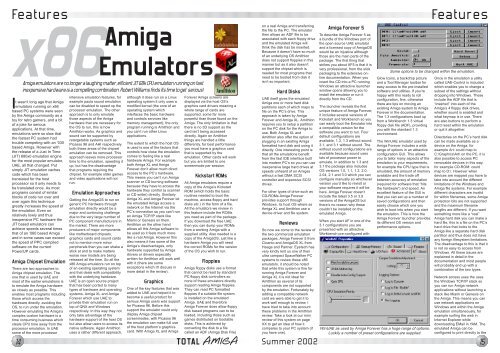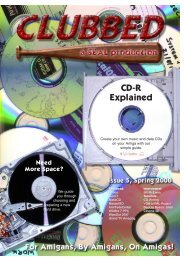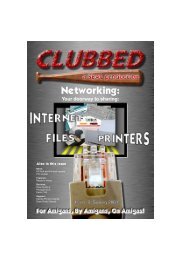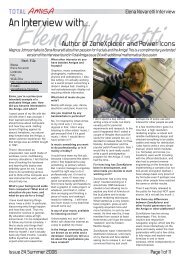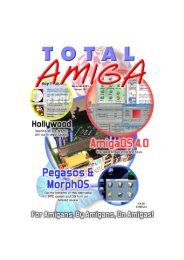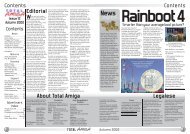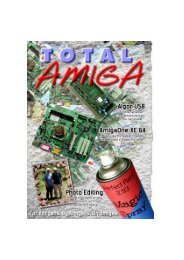Download issue 11 - Total Amiga Magazine
Download issue 11 - Total Amiga Magazine
Download issue 11 - Total Amiga Magazine
You also want an ePaper? Increase the reach of your titles
YUMPU automatically turns print PDFs into web optimized ePapers that Google loves.
x86<br />
Features<br />
<strong>Amiga</strong><br />
Emulators<br />
<strong>Amiga</strong> emulators are no longer a laughing matter, efficient JIT 68k CPU emulation running on fast<br />
inexpensive hardware is a compelling combination. Robert Williams finds it’s time to get serious!<br />
It wasn’t long ago that <strong>Amiga</strong><br />
emulators running on x86<br />
based PC systems were seen<br />
by the <strong>Amiga</strong> community as a<br />
toy for retro gamers, and a bit<br />
of a joke for serious<br />
applications. At that time,<br />
emulations were so slow that<br />
the fastest PC system had<br />
trouble competing with an ‘030<br />
based <strong>Amiga</strong>. However with<br />
the release of a Just In Time<br />
(JIT) 680x0 emulation engine<br />
for the most popular emulator,<br />
UAE, all that changed. Put<br />
simply JIT emulation caches<br />
code which has been<br />
translated for the host<br />
processor so it only needs to<br />
be translated once. As most<br />
programs consist of similar<br />
blocks of code run over and<br />
over again this technique<br />
greatly increases the speed of<br />
the emulation. Even on<br />
relatively lowly and thus<br />
inexpensive PC hardware the<br />
JIT based emulators can<br />
achieve speeds several times<br />
that of an ‘060 based <strong>Amiga</strong><br />
and in some cases can exceed<br />
the speed of PPC compiled<br />
software on the current<br />
PowerUP cards.<br />
<strong>Amiga</strong> Chipset Emulation<br />
There are two approaches to<br />
<strong>Amiga</strong> chipset emulation. The<br />
one that is used by UAE and<br />
most of the earlier emulations is<br />
to emulate the <strong>Amiga</strong> hardware<br />
as closely as possible. This<br />
enables most programs including<br />
those which access the<br />
hardware directly, avoiding the<br />
OS, to run under the emulation.<br />
However emulating the <strong>Amiga</strong>’s<br />
complex custom hardware is a<br />
time consuming business which<br />
steals CPU time away from the<br />
processor emulation. In UAE<br />
some of the more processor<br />
intensive emulation features, for<br />
example paula sound emulation<br />
can be disabled to speed up the<br />
processor emulation. The other<br />
approach is to only emulate<br />
those aspects of the <strong>Amiga</strong><br />
hardware that are necessary for<br />
the OS to run, this is how<br />
Amithlon works. As graphics and<br />
sound can be supported by<br />
retargetable systems such as<br />
Picasso 96 and AHI respectively<br />
both these areas of the chipset<br />
emulation can be removed. This<br />
approach leaves more processor<br />
time to the emulation, speeding it<br />
up, but has the disadvantage<br />
that programs requiring the<br />
chipset, for example older games<br />
and video applications will not<br />
run.<br />
Emulation Approaches<br />
Getting the <strong>Amiga</strong>OS to run on<br />
generic PC hardware through<br />
emulation directly would be a<br />
major and continuing challenge<br />
due to the very large number of<br />
PC component manufacturers in<br />
the market. There are more<br />
producers of major components<br />
like motherboard chipsets,<br />
graphics cards and sound cards<br />
not to mention more minor<br />
peripherals than you can shake a<br />
stick at and to make matters<br />
worse new models are being<br />
released all the time. So all the<br />
x86 <strong>Amiga</strong> emulators run on top<br />
of an existing operating system<br />
and that deals with compatibility<br />
with the underlying hardware.<br />
UAE is an open source project<br />
that has been ported to many<br />
types of hardware and operating<br />
systems. <strong>Amiga</strong> XL and <strong>Amiga</strong><br />
Forever which use UAE to<br />
provide their emulation run on<br />
top of QNX and Windows<br />
respectively. In this way they not<br />
only take advantage of the<br />
hardware support of the host OS<br />
but also allow users to access its<br />
native software. Again Amithlon<br />
uses a rather different approach,<br />
although it does run on a Linux<br />
operating system it only uses a<br />
modified kernal (the core of an<br />
operating system which<br />
interfaces the basic hardware<br />
and controls services like<br />
memory management), the only<br />
program running is Amithlon and<br />
you can’t run other Linux<br />
applications.<br />
The extent to which the host OS<br />
is used is one of the factors that<br />
controls how close the emulation<br />
comes to feeling like a real<br />
hardware <strong>Amiga</strong>. For example<br />
both <strong>Amiga</strong> XL and <strong>Amiga</strong><br />
Forever don’t allow much direct<br />
access to the PC’s hardware.<br />
This means you can’t run <strong>Amiga</strong><br />
scanner or CD burning software<br />
because they have to access the<br />
hardware they control (a scanner<br />
or CD writer) directly. Similarly<br />
<strong>Amiga</strong> XL and <strong>Amiga</strong> Forever let<br />
the emulated <strong>Amiga</strong> access a<br />
network or the Internet via the<br />
PC’s connection so you can’t run<br />
an <strong>Amiga</strong> TCP/IP stack like<br />
Miami or Genesis on them.<br />
Amithlon on the other hand<br />
allows all this <strong>Amiga</strong> software to<br />
be used so it feels much more<br />
like a real <strong>Amiga</strong>. However this<br />
also means it has some of the<br />
<strong>Amiga</strong>’s disadvantages, only<br />
hardware supported by <strong>Amiga</strong><br />
drivers or drivers especially<br />
written for Amithlon will work well<br />
with it (there are some<br />
exceptions which I’ll discuss in<br />
more detail in the review).<br />
Graphics<br />
One of the key features that was<br />
added to UAE and helped it to<br />
become a useful product for<br />
serious <strong>Amiga</strong> users was support<br />
for Picasso 96. Before this<br />
support the emulator could only<br />
display <strong>Amiga</strong> chipset<br />
screenmodes, with Picasso 96<br />
the emulation can make full use<br />
of the host platform’s graphics<br />
card. With <strong>Amiga</strong> XL and <strong>Amiga</strong><br />
Forever <strong>Amiga</strong> screens are<br />
displayed via the host OS’s<br />
graphics card drivers meaning a<br />
whole range of cards are<br />
supported, some far more<br />
powerful than those found on the<br />
<strong>Amiga</strong>. The only limitation is that<br />
there is no 3D support as the<br />
card isn’t being accessed<br />
directly. Again on Amithlon<br />
things are handled a little<br />
differently, for best performance<br />
you must have a graphics card<br />
that is supported by the<br />
emulation. Other cards will work<br />
but you are limited to one<br />
screenmode per session.<br />
Kickstart ROMs<br />
All <strong>Amiga</strong> emulators require a<br />
copy of the <strong>Amiga</strong>’s Kickstart<br />
ROM (which holds the basic<br />
routines needed to boot the<br />
machine, access floppy and hard<br />
disks etc.) in the form of a file.<br />
All the emulators we review in<br />
this feature include the ROMs<br />
you need as part of the package.<br />
If you download the free UAE<br />
then you can dump your ROMs<br />
from a working <strong>Amiga</strong> with a<br />
supplied utility. Also needed is a<br />
copy of the <strong>Amiga</strong>OS, just like a<br />
hardware <strong>Amiga</strong> you will need<br />
the correct ROMs for the version<br />
of the OS you wish to run.<br />
Floppies<br />
<strong>Amiga</strong> floppy disks use a format<br />
that cannot be read by standard<br />
PC floppy disk controllers so<br />
none of these emulators directly<br />
support reading <strong>Amiga</strong> floppies.<br />
They can read PC formatted<br />
floppies if a suitable file system<br />
is installed on the emulated<br />
<strong>Amiga</strong>. UAE and therefore<br />
<strong>Amiga</strong> Forever does allow floppy<br />
disk based programs can to be<br />
loaded, including those such as<br />
games distributed on bootable<br />
disks. This is achieved by<br />
converting the disk to a file<br />
called an ADF (<strong>Amiga</strong> DIsk File)<br />
on a real <strong>Amiga</strong> and transferring<br />
the file to the PC. The emulator<br />
then allows an ADF file to be<br />
associated with each floppy drive<br />
and the emulated <strong>Amiga</strong> will<br />
think the disk has be inserted.<br />
Because it doesn’t have so much<br />
of an underlying OS Amithlon<br />
does not support floppies in this<br />
manner but as it also doesn’t<br />
support the chipset which is<br />
needed for most programs that<br />
need to be booted from disk it<br />
isn’t so important.<br />
Features<br />
14 TOTAL AMIGA Summer 2002<br />
15<br />
Hard Disks<br />
UAE itself gives the emulated<br />
<strong>Amiga</strong> one or more hard disk<br />
partitions each of which maps to<br />
file on the PC’s drive. This<br />
approach is taken by <strong>Amiga</strong><br />
Forever and <strong>Amiga</strong> XL. Amithlon<br />
requires you to setup a partition<br />
on the PC disk for the <strong>Amiga</strong> to<br />
use. Both <strong>Amiga</strong> XL and<br />
Amithlon also offer the option of<br />
plugging in an existing <strong>Amiga</strong><br />
formatted hard disk and using it<br />
directly. One interesting point is<br />
that all the emulations benefit<br />
from the fast IDE interface built<br />
into modern PC’s so you can use<br />
inexpensive large hard drives at<br />
speeds unheard of on <strong>Amiga</strong>s<br />
without a fast DMA SCSI<br />
controller and expensive SCSI<br />
drives.<br />
For other types of drive such as<br />
CD-ROMs <strong>Amiga</strong> Forever<br />
provides support through<br />
Windows, its host OS where as<br />
<strong>Amiga</strong> XL and Amithlon use a<br />
device driver and file system.<br />
Reviews<br />
So now we come to the review of<br />
the two commercial emulation<br />
packages, <strong>Amiga</strong> Forever 5 from<br />
Cloanto and <strong>Amiga</strong>OS XL from<br />
Haage and Partner. Eyetech has<br />
very kindly lent us one of their<br />
ultra compact SpaceWalker PC<br />
systems to review these x86<br />
emulators, it should be noted<br />
that while this system is fine for<br />
running <strong>Amiga</strong> Forever and<br />
<strong>Amiga</strong> XL it is not ideal for<br />
Amithlon as several of its<br />
components are not supported<br />
by the emulation. Fortunately by<br />
adding a compatible network<br />
card we were able to get it to<br />
work well enough to review, I<br />
have tried to take into account<br />
these problems in the Amithlon<br />
review. Take a look at our mini<br />
review of this system on page<br />
XX to get an idea of how it<br />
compares to your PC system (if<br />
you have one).<br />
<strong>Amiga</strong> Forever 5<br />
To describe <strong>Amiga</strong> Forever 5 as<br />
a bundle of the Windows port of<br />
the open source UAE emulator<br />
and a licensed copy of <strong>Amiga</strong>OS<br />
would be an injustice although<br />
those are the main parts of the<br />
package. The first thing that<br />
strikes you about AF5 is that it is<br />
very professional, from the slick<br />
packaging to the extensive online<br />
documentation. When you<br />
insert the CD into a PC running<br />
Windows an attractive launcher<br />
window opens allowing you to<br />
install the emulator or run it<br />
directly from the CD.<br />
The launcher reveals the first<br />
unique feature of <strong>Amiga</strong> Forever,<br />
it includes several versions of<br />
Kickstart and Workbench so you<br />
can easily boot the Emulator into<br />
a compatible version for the<br />
software you want to run. Four<br />
default configurations are<br />
available, 1.3, 1.3 without sound,<br />
3.1, and 3.1 without sound. The<br />
without sound configurations are<br />
available because sound uses<br />
lots of processor power to<br />
emulate. In addition to 1.3 and<br />
3.1 the package also includes<br />
OS versions 1.0, 1.1, 1.2, 2.0,<br />
2.04, 2.1 and 3.0 which you can<br />
configure manually so whichever<br />
version you’d like to revisit or<br />
your software requires it will be<br />
here. <strong>Amiga</strong> Forever doesn’t<br />
include the latest 3.5 or 3.9<br />
versions of the <strong>Amiga</strong>OS but<br />
there’s no reason why these<br />
couldn’t be installed on the<br />
emulated <strong>Amiga</strong>.<br />
When you start AF in one of the<br />
3.1 configurations you are<br />
presented with an attractive<br />
Workbench pre-configured with<br />
Glow Icons, a backdrop picture<br />
and a Tool Manager toolbar for<br />
easy access to the pre-installed<br />
software and utilities. If you’re<br />
happy with this ready to roll<br />
configuration, fine, otherwise<br />
there are tips on moving an<br />
existing <strong>Amiga</strong> system to <strong>Amiga</strong><br />
Forever in the documentation.<br />
The 1.3 configurations boot up<br />
from a Workbench 1.3 virtual<br />
floppy disk file (ADF), providing<br />
you with the standard 1.3<br />
environment.<br />
The WinUAE emulator used by<br />
<strong>Amiga</strong> Forever includes a wide<br />
range of options in an attractive<br />
configuration GUI. This allows<br />
you to tailor many aspects of the<br />
emulation to your requirements,<br />
for example the CPU type that is<br />
emulated, the amount of memory<br />
available and the trade off<br />
between accuracy of emulation<br />
(required for software that “hits<br />
the hardware”) and speed. An<br />
excellent feature of the GUI is<br />
that you can set up a number of<br />
saved configurations and then<br />
easily choose which one you<br />
wish to boot into when you start<br />
the emulation. This is how the<br />
<strong>Amiga</strong> Forever launcher provides<br />
its different OS version and<br />
performance options.<br />
WinUAE as used by <strong>Amiga</strong> Forever has a huge range of options.<br />
Luckily a number of preset configurations are supplied.<br />
Some options to be changed within the emulation.<br />
Once in the emulation a utility<br />
called UAE-Control is included<br />
which enables you to change a<br />
subset of the settings without<br />
dropping into Windows. These<br />
include the ADF file that is<br />
“inserted” into each of the<br />
<strong>Amiga</strong>’s 4 floppy disk drives,<br />
whether sound is enabled and<br />
what keymap is in use. There<br />
are also buttons to perform a<br />
hard reset within the emulation<br />
or quit it altogether.<br />
Directories on the PC’s hard disk<br />
can be made available as a<br />
device on the <strong>Amiga</strong>, for<br />
example Art: could map to<br />
C:\Graphics\Art\ on the PC, it is<br />
also possible to access PC<br />
removable devices in this way,<br />
for example CD-ROM: could<br />
map to D:\. However when<br />
devices are mapped you have to<br />
take into account the different<br />
limitations of the Windows and<br />
<strong>Amiga</strong> file systems. For example<br />
different characters are invalid<br />
for within filenames, some <strong>Amiga</strong><br />
protection bits are not supported<br />
and the maximum filename<br />
lengths are different. If you want<br />
something more like a “real”<br />
<strong>Amiga</strong> hard disk you can make a<br />
hard file, this is a file on the PC’s<br />
hard drive that looks to the<br />
<strong>Amiga</strong> like a separate hard disk<br />
partition and thus does not have<br />
any foreign filesystem limitations.<br />
The disadvantage to this is that it<br />
is not so easy to access from<br />
Windows. All these <strong>issue</strong>s are<br />
explained in detail in the<br />
documentation and most people<br />
will probably end up with a<br />
combination of the two types.<br />
Network access uses the uses<br />
the Windows TCP/IP stack so<br />
you can run <strong>Amiga</strong> network<br />
applications without launching a<br />
stack like Miami or Genesis on<br />
the <strong>Amiga</strong>. This means you can<br />
use network applications on<br />
Windows and within the <strong>Amiga</strong><br />
emulation simultaneously, for<br />
example surfing the web in<br />
Internet Explorer while<br />
downloading EMail in YAM. The<br />
emulated <strong>Amiga</strong> can be<br />
configured to print directly to the


